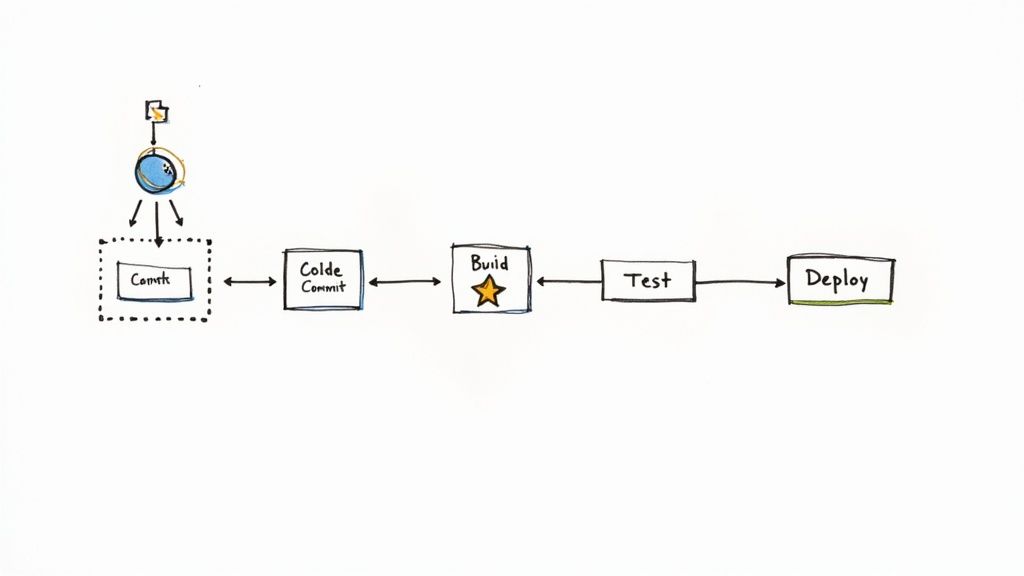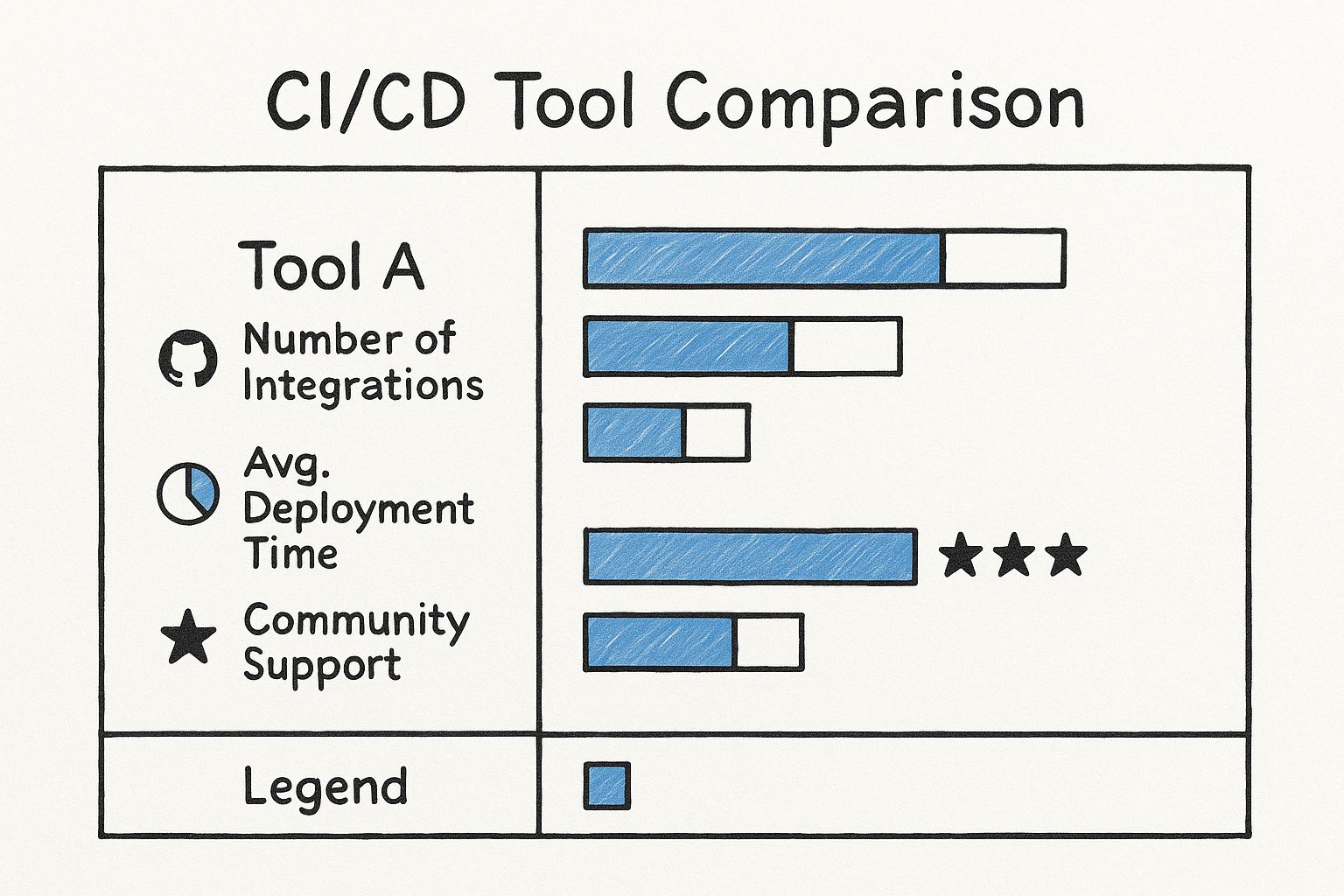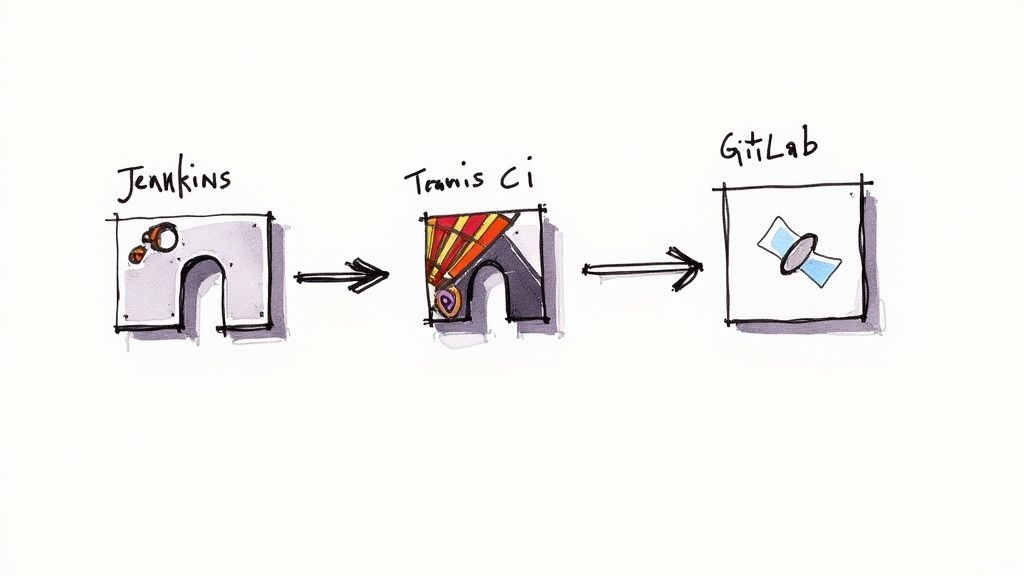A Deep Dive CICD Tools Comparison
An expert CICD tools comparison of Jenkins, GitLab CI, CircleCI, and GitHub Actions. Discover the best tool for your specific DevOps workflow and use case.

Choosing the right CI/CD tool is a critical engineering decision. It often comes down to a classic trade-off: do you want the complete, low-level control of a self-hosted tool like Jenkins, or the streamlined, integrated experience of SaaS platforms like GitLab CI/CD, CircleCI, and GitHub Actions? There's no single right answer. The best choice depends entirely on your team's existing workflow, technical stack, required deployment velocity, and infrastructure strategy. This guide will provide a deep, technical analysis of these top contenders to help you make an informed decision.
Understanding the CI/CD Landscape

Selecting a CI/CD tool is a strategic decision that dictates the architecture of your entire software delivery lifecycle. As DevOps practices mature from a trend to an industry standard, the market for these tools is expanding rapidly. To make an optimal choice, you need a firm grasp of the underlying technical principles, such as those covered in understanding Continuous Deployment.
Market data underscores this shift. The global market for Continuous Integration tools was valued at over USD 8.82 billion in 2025 and is projected to skyrocket to approximately USD 43.13 billion by 2035, growing at a compound annual growth rate of roughly 17.2%. This growth reflects the industry-wide imperative to automate software delivery to increase release frequency and reduce lead time for changes.
Core Pillars of a Modern CI/CD Tool
Any robust CI/CD platform is built on several fundamental technical pillars. These are the non-negotiable requirements that determine its effectiveness and scalability for your engineering organization.
- Automation: The primary function is to automate the build, test, and deploy stages of the software development lifecycle, minimizing manual intervention and the risk of human error. This is achieved through scripted pipelines that execute in response to triggers, like a
git push. - Integration: The tool must integrate seamlessly with your existing toolchain. This includes deep integration with version control systems (e.g., Git), artifact repositories (e.g., Artifactory, Nexus), container registries (e.g., Docker Hub, ECR), and cloud infrastructure providers (e.g., AWS, GCP, Azure).
- Feedback Loops: When a build or test fails, the tool must provide immediate, context-rich feedback to developers. This includes detailed logs, test failure reports, and status checks directly on pull requests, enabling rapid debugging and resolution. For more detail, see our guide on what is Continuous Integration.
A modern CI/CD tool serves as the orchestration engine for your DevOps workflow. It doesn't just execute scripts; it manages the entire flow of value from a developer's local commit to a fully deployed application in a production environment.
Initial Comparison of Leading Tools
Before we perform a deep technical analysis, let's establish a high-level overview of the four tools under comparison. This table outlines their core architectural philosophies and primary use cases, setting the stage for the detailed breakdown to follow.
| Tool | Primary Philosophy | Hosting Model | Typical Use Case |
|---|---|---|---|
| Jenkins | Extensibility & Control | Primarily Self-Hosted | Teams requiring maximum customization for complex or legacy workflows, with the resources to manage infrastructure. |
| GitLab CI/CD | All-in-One DevOps Platform | SaaS & Self-Hosted | Organizations seeking a single, unified platform for the entire SDLC, from planning and SCM to CI/CD and monitoring. |
| CircleCI | Performance & Speed | Primarily SaaS | Performance-critical projects where build speed and fast feedback loops are the highest priority. |
| GitHub Actions | VCS-Integrated Automation | Primarily SaaS | Teams deeply embedded in the GitHub ecosystem who want native, event-driven CI/CD and repository automation. |
A Technical Showdown of Core Architecture
The core architecture of a CI/CD tool—how it defines pipelines, executes jobs, and manages workflows—is its most critical differentiator. This foundation directly impacts developer experience, scalability, and maintenance overhead. Let's dissect the architectural models of Jenkins, GitLab CI/CD, CircleCI, and GitHub Actions.
Pipeline definition is the starting point. Jenkins, the long-standing incumbent, utilizes the Jenkinsfile, which is a script written in a Domain-Specific Language (DSL) based on Groovy—a Turing-complete language. This provides immense power, allowing for dynamic pipeline generation, complex conditional logic, and programmatic control flow directly within the pipeline definition. However, this power introduces significant complexity, a steep learning curve, and the potential for unmaintainable, overly imperative pipeline code.
Conversely, GitLab CI/CD, CircleCI, and GitHub Actions have standardized on declarative YAML. This approach prioritizes simplicity, readability, and a clear separation of concerns by defining what the pipeline should do, rather than how. For most teams, YAML is far more approachable than Groovy, leading to faster adoption and more maintainable pipelines. The trade-off is that complex logic often needs to be abstracted into external scripts (e.g., Bash, Python) that are invoked from the YAML, as YAML itself is not a programming language.
Execution Models: A Head-to-Head Comparison
The job execution model is a key architectural differentiator. Jenkins employs a classic main/agent (formerly master/slave) architecture. A central Jenkins controller orchestrates jobs and dispatches them to a fleet of agents, which can be bare-metal servers, VMs, or containers. This provides maximum control over the build environment but saddles the user with the significant operational burden of managing, scaling, securing, and patching the agent fleet.
GitLab CI/CD uses a similar but more modernized approach with its GitLab Runners. While you can self-host runners for granular control, GitLab's SaaS offering also provides a fleet of shared, auto-scaling runners, abstracting away the infrastructure management. This hybrid model offers a compelling balance between control and convenience.
CircleCI was architected with a container-first philosophy. Every job executes in a clean, ephemeral container or VM, ensuring a consistent, isolated environment for every run. This model is excellent for performance and eliminates the "dependency hell" that can plague persistent build agents. While self-hosted runners are an option, CircleCI's primary value proposition lies in its highly optimized cloud execution environment.
GitHub Actions introduces an event-driven model. Workflows are triggered by a wide array of events within a GitHub repository—such as a
push, apull_requestcreation, a comment on anissue, or even a scheduledcronjob. This tight coupling with the VCS enables powerful, context-aware automations that extend far beyond traditional CI/CD, transforming the repository into a programmable automation platform.
To crystallize these architectural differences, here is a summary table.
Architectural and Feature Comparison
| Attribute | Jenkins | GitLab CI/CD | CircleCI | GitHub Actions |
|---|---|---|---|---|
| Pipeline Definition | Groovy DSL (Jenkinsfile) | Declarative YAML (.gitlab-ci.yml) |
Declarative YAML (.circleci/config.yml) |
Declarative YAML (.github/workflows/*.yml) |
| Execution Model | Main/Agent (self-managed) | Shared/Self-Hosted Runners | Container/VM-First (SaaS-first) | Event-Driven (SaaS & self-hosted runners) |
| Primary Strength | Unparalleled plugin ecosystem | Fully integrated DevOps platform | Build performance & developer experience | Deep GitHub integration & community marketplace |
| Learning Curve | High | Low-to-Medium | Low | Low |
This table illustrates how the foundational design choices of each tool result in distinct operational characteristics and developer experiences.
Critical Differentiators in Practice
Let's examine how these architectural decisions manifest in code and features.
The infographic below highlights key metrics like integrations and performance, which are direct outcomes of each tool's underlying architecture.

As shown, a tool's design directly impacts its extensibility and the velocity at which it can deliver software.
For Jenkins, the defining feature is its massive plugin ecosystem. If you need to integrate with an obscure, legacy, or proprietary system, a Jenkins plugin likely exists. This is its greatest strength but also its Achilles' heel; managing dozens of plugins, their dependencies, and security vulnerabilities can become a significant maintenance burden.
GitLab CI/CD's primary advantage is its seamless integration into the broader GitLab platform. Features like a built-in container registry, integrated security scanning (SAST, DAST, dependency scanning), and Review Apps are available out-of-the-box. This creates a cohesive, single-vendor DevOps platform. Consider this .gitlab-ci.yml snippet that enables SAST:
include:
- template: Security/SAST.gitlab-ci.yml
sast:
stage: test
This single include line leverages a managed template to run a sophisticated security job. Replicating this functionality in Jenkins would require manually installing, configuring, and maintaining multiple plugins.
Finally, GitHub Actions excels with its concept of reusable workflows and the extensive Actions Marketplace. Teams can create and share composite actions, reducing boilerplate code and enforcing organizational best practices. A complex deployment workflow can be encapsulated into a single action and invoked with just a few lines of YAML, promoting modularity and consistency across hundreds of repositories.
Comparing Hosting Models and Deployment Strategies
The choice of hosting model—self-managed on-premise/private cloud versus a fully managed SaaS solution—is a critical architectural decision. It directly influences operational overhead, security posture, scalability, and total cost of ownership (TCO). Each model presents a distinct set of trade-offs that must be evaluated against your organization's technical and compliance requirements.
Historically, on-premise solutions were dominant, particularly in large, regulated enterprises. As of 2024, on-prem deployments still account for a substantial 65% market share, driven by sectors like finance and healthcare with stringent data sovereignty and privacy requirements. However, the cloud deployment segment is growing at an accelerated rate of around 20% through 2029, signaling a clear industry trajectory. You can discover more insights about the continuous integration tools market on Mordor Intelligence.
Self-Hosted Dominance: Jenkins and GitLab
Jenkins is the quintessential self-hosted powerhouse. Its core strength is the complete, granular control it provides. You manage the underlying hardware, operating system, Java runtime, and every plugin. This is ideal for scenarios requiring deep customization, air-gapped secure environments, or builds on specialized hardware like GPUs or ARM-based architectures.
However, this control comes with significant maintenance overhead. You are responsible for everything: patching vulnerabilities, scaling build agents, resolving plugin compatibility issues, and securing the entire installation. This model demands a dedicated infrastructure team or a significant portion of engineering time, effectively making your CI/CD platform another critical service to manage.
Similarly, GitLab offers a powerful self-managed edition, allowing you to run its entire DevOps platform on your own infrastructure. This is the preferred solution for organizations that require GitLab's comprehensive feature set but are precluded from using public cloud services due to data sovereignty or security policies. It provides the same unified experience as the SaaS version, but the operational responsibility for uptime, scaling, and updates rests entirely with your team.
The Cloud-Native Approach: CircleCI and GitHub Actions
CircleCI is a cloud-native SaaS platform designed from the ground up to abstract away infrastructure management. Its primary focus is on delivering a high-performance, managed build environment that is ready to use. For organizations that require a self-hosted solution, CircleCI also offers a server installation, allowing them to maintain control over their environment while leveraging CircleCI's platform features.
GitHub Actions is fundamentally a cloud-first service, deeply integrated into the GitHub ecosystem. It provides managed runners that are automatically provisioned and scaled by GitHub. For open-source projects and teams starting with private repositories, this model is extremely convenient, offering zero-setup CI/CD with a generous free tier.
The key advantage of the GitHub Actions hosting model is its hybrid flexibility. You can register your own self-hosted runners—your own VMs, bare-metal servers, or Kubernetes pods—to execute jobs. This is a crucial feature for teams needing specialized hardware (e.g., macOS for iOS builds), access to resources within a private network (VPC), or stricter security controls. It effectively blends the convenience of a SaaS orchestrator with the power of on-premise execution.
This hybrid approach allows teams to optimize for cost, security, and performance. You can run standard, non-sensitive jobs on GitHub's managed infrastructure while routing specialized or high-security jobs to your own hardware. To fully leverage these tools, an understanding of modern deployment patterns is essential. Our guide on what is blue-green deployment explores how these strategies integrate into a CI/CD pipeline.
Benchmarking Performance and Scalability

The performance of a CI/CD tool is not merely about raw build speed. It's a deeper function of its concurrency model, resource utilization efficiency, and ability to scale under load. A platform's architecture for handling heavy workloads directly impacts developer productivity and your organization's ability to ship features quickly.
This section provides a technical benchmark of how the leading tools perform under pressure, focusing on the implementation details of caching, parallelization, and runner architecture. These are the core components that dictate build times, cost, and scalability.
Advanced Caching Strategies Compared
Effective caching is a critical optimization for accelerating pipelines by reusing dependencies and build artifacts. However, the implementation details vary significantly between platforms.
CircleCI is widely recognized for its advanced caching capabilities, particularly its native layer caching for Docker images. By intelligently caching individual layers, it can dramatically accelerate subsequent image builds by only rebuilding changed layers. For container-centric workflows, this is a significant performance advantage.
GitLab CI/CD provides a flexible, key-based caching mechanism. You explicitly define cache keys and paths in your .gitlab-ci.yml file. This offers fine-grained control but requires careful management to avoid issues like cache poisoning, where a corrupted cache breaks subsequent builds.
GitHub Actions offers a versatile cache action that works across different runner operating systems. It uses a key-based system similar to GitLab's, restoring a cache if an exact key match is found or falling back to a partial match (restore-keys). It is effective for dependencies but lacks the specialized Docker layer caching that CircleCI provides natively.
A well-architected caching strategy can reduce build times by over 50% for dependency-heavy projects (e.g., those using
npm,Maven, orpip). The optimal choice depends on which tool's caching model best aligns with your primary build artifacts, be they Node.js modules, Java packages, or Docker layers.
Parallelization and Concurrency Models
As test suites grow, sequential execution becomes a major bottleneck. Parallelization—splitting tests across multiple concurrent runners—is the solution for reducing execution time.
- CircleCI Test Splitting: CircleCI offers first-class support for test splitting. It can automatically divide test files across parallel containers based on historical timing data, ensuring that each parallel job finishes at roughly the same time for maximum efficiency.
- GitLab Parallel Keyword: GitLab provides a simple
parallelkeyword in its configuration. This allows you to easily spin up multiple instances of a single job, making it straightforward to parallelize test suites or other distributable tasks. - GitHub Actions Matrix Builds: GitHub Actions uses matrix strategies to run jobs in parallel. While primarily designed for testing across different language versions, operating systems, or architectures, a matrix can be creatively used to shard tests across parallel jobs.
For ultimate control, a scripted Jenkins pipeline allows you to use Groovy to dynamically generate parallel stages based on arbitrary logic—a level of programmatic flexibility not easily achieved with declarative YAML.
Runner Architecture and Resource Management
The architecture of your build agents ("runners") directly impacts scalability, cost, and security. Self-hosted options like Jenkins agents or GitLab Runners provide total control but necessitate full operational ownership.
Cloud-native platforms manage this for you. CircleCI's model, where each job runs in a clean, ephemeral container, provides maximum isolation and reproducibility, effectively eliminating "works on my machine" issues.
GitHub Actions offers a hybrid model with both managed and self-hosted runners. The managed runners are auto-scaling and fully maintained by GitHub. However, the ability to use self-hosted runners provides a critical escape hatch for jobs that require specialized hardware (e.g., GPUs for ML model training), access to internal networks, or have specific compliance requirements. This hybrid architecture offers an optimal balance for organizations with diverse needs.
Evaluating Ecosystems and Extensibility
A CI/CD tool's true power is often measured not by its built-in features, but by its ability to integrate with the broader DevOps toolchain. A robust ecosystem of plugins and integrations prevents platform lock-in and saves significant engineering effort, allowing the tool to adapt to your existing stack.
This is a critical factor in any tool comparison. How a platform integrates with source control, artifact repositories, security scanners, and cloud providers directly determines its utility. Let's analyze the distinct extensibility models of Jenkins, GitLab, CircleCI, and GitHub Actions.
Jenkins: The Unrivaled Plugin Library
In terms of sheer integration volume, Jenkins is unparalleled. Its open-source community has developed an extensive library of over 1,800 community-contributed plugins. If you need to connect to a niche, legacy, or proprietary third-party system, a Jenkins plugin almost certainly exists.
This vast library provides incredible flexibility for automating virtually any workflow. However, this strength comes with a significant trade-off: maintenance overhead. Managing dozens of plugins, their dependencies, security vulnerabilities, and frequent updates can become a full-time administrative task.
GitLab: The All-in-One Platform
GitLab CI/CD adopts the opposite philosophy. Instead of relying on a vast ecosystem of external plugins, it aims to be an all-in-one DevOps platform by integrating most required functionalities directly into its core product. Features such as a container registry, advanced security scanning (SAST, DAST), and package management are available natively.
This tightly integrated model simplifies the toolchain and ensures that components work together seamlessly. The trade-off is that you are adopting the "GitLab way." If your organization is already standardized on external tools like Artifactory for artifact management or SonarQube for code analysis, integrating them can be less straightforward than with a plugin-first tool like Jenkins.
For organizations looking to consolidate their toolchain and reduce vendor sprawl, GitLab’s integrated ecosystem presents a compelling value proposition. It offers a single source of truth for the entire software development lifecycle, enhancing traceability and simplifying administration.
CircleCI Orbs and GitHub Actions Marketplace
CircleCI and GitHub Actions have adopted modern, package-based extensibility models that combine flexibility with a superior user experience.
-
CircleCI Orbs: These are reusable, shareable packages of YAML configuration. Orbs encapsulate commands, jobs, and executors into a single, parameterizable unit, drastically reducing boilerplate in
config.ymlfiles. An Orb can simplify complex tasks like deploying to AWS, running security scans, or sending Slack notifications into a single line of code. -
GitHub Actions Marketplace: This is a vibrant ecosystem where the community and vendors can publish and share pre-built Actions. Thousands of Actions are available for nearly any task, from setting up a specific version of Node.js to deploying an application to a Kubernetes cluster.
Both Orbs and the Actions Marketplace strike a balance between the power of Jenkins plugins and the simplicity of GitLab's built-in features. They promote code reuse and best practices, enabling teams to construct complex pipelines efficiently without the administrative burden of managing underlying plugin infrastructure.
Total Cost of Ownership and Pricing Models

Evaluating a CI/CD platform requires looking beyond the sticker price to the Total Cost of Ownership (TCO). This includes "hidden" costs such as infrastructure, ongoing maintenance, and the engineering hours required to operate the system. These indirect costs can significantly alter the financial analysis of what initially appears to be the most economical option.
The CI/CD tools market is experiencing significant growth—it was valued at USD 9.41 billion in 2025 and is projected to reach USD 33.63 billion by 2034, with a CAGR of approximately 15.19%. This level of investment underscores the importance of making a financially sound, long-term decision.
The Hidden Costs of Open Source
"Free" open-source tools like Jenkins carry substantial operational costs. When calculating the TCO of a self-hosted Jenkins instance, you must account for several factors:
- Infrastructure Provisioning: You are responsible for provisioning, configuring, and scaling all server resources—both for the central controller and the entire fleet of build agents.
- Maintenance and Upgrades: This is a continuous effort, involving patching the core application and its plugins, managing the Java runtime, and resolving compatibility issues after updates.
- Dedicated Engineering Time: This is often the largest hidden cost. A significant amount of engineering time is diverted from product development to maintaining the CI/CD system. It’s crucial to think through evaluating total cost, ROI, and risk for open-source versus paid options before making a commitment.
Dissecting SaaS Pricing Models
SaaS platforms like CircleCI and GitHub Actions offer more predictable pricing but require careful monitoring to avoid unexpected costs. Their models typically scale based on usage, metered by a few common metrics.
A common pitfall is underestimating the growth of build-minute consumption. A small team may operate comfortably within a free tier, but as test suites expand and deployment frequency increases, costs can escalate rapidly.
These platforms utilize several pricing levers:
- Build Minutes: The core metric, representing the raw compute time consumed by your pipelines.
- User Seats: The number of active developers with access to the platform.
- Concurrency: The number of jobs that can be run simultaneously. Higher concurrency reduces pipeline wait times but increases cost.
GitLab employs a tiered pricing model for both its SaaS and self-managed offerings. Each tier—Free, Premium, and Ultimate—unlocks a progressively richer feature set, such as advanced security scanning or compliance management capabilities. This model requires you to align your feature requirements with the appropriate pricing level. To manage these expenses effectively, it is beneficial to apply cloud cost optimization strategies, ensuring you only pay for the resources and features you actively use.
Answering Your CI/CD Tool Questions
Selecting a platform is a major engineering decision, and several key questions frequently arise during the evaluation process. Let's address them directly to provide a clear path forward.
Which CI/CD Tool Is Best for a Small Startup?
For most startups, GitHub Actions or CircleCI are the recommended starting points. Both offer robust free tiers, use straightforward YAML configuration, and, most importantly, abstract away infrastructure management. This is a significant advantage for small teams with limited operational capacity.
If your source code is hosted on GitHub, Actions is the natural choice. Its native integration provides a seamless developer experience from commit to deployment with zero initial setup. Alternatively, CircleCI is renowned for its superior build performance and excellent debugging features, such as the ability to SSH into a running job to inspect its state. For agile teams where development velocity is paramount, these features can be a decisive factor.
How Complex Is Migrating from Jenkins?
Migrating from Jenkins is a common but non-trivial undertaking. The primary technical challenge is translating imperative Jenkinsfile Groovy scripts into the declarative YAML format used by modern CI/CD tools.
The most significant hurdle is not the script conversion itself, but replicating the functionality of deeply embedded, and often obscure, Jenkins plugins. A successful migration is less about a line-for-line translation and more about re-architecting your delivery process using modern, cloud-native principles.
A typical migration project involves several phases:
- Runner/Agent Configuration: You must set up and configure new execution environments, such as GitLab Runners or GitHub Actions self-hosted runners, to mirror the build dependencies and tools available on your Jenkins agents.
- Secure Secrets Migration: All credentials, API keys, and environment variables must be securely migrated from Jenkins's credential store to the target platform's secrets management system (e.g., GitHub Secrets, GitLab CI/CD variables).
- Phased Project Migration: Do not attempt a "big bang" migration. Start with a small, non-critical application to establish a migration pattern and create a playbook. Use this initial project to iron out the process before tackling mission-critical services.
What Is the Key Advantage of a Platform-Integrated Tool?
The primary advantage of using a platform-integrated tool like GitLab CI or GitHub Actions is the creation of a unified DevOps platform. This significantly reduces the complexity associated with stitching together and maintaining a disparate set of point solutions.
When your source code management, CI/CD pipelines, package registries, and security scanning all reside within a single platform, you eliminate context-switching for developers and simplify administration. This deep integration provides end-to-end traceability, from the initial commit to a production deployment, creating a single source of truth for the entire development lifecycle and dramatically improving collaboration and visibility.
Ready to build out a powerful CI/CD strategy but could use an expert guide? At OpsMoon, we connect you with the top 0.7% of remote DevOps engineers to build, scale, and fine-tune your pipelines. Start with a free work planning session today and let's map out your path to automated, reliable software delivery.
